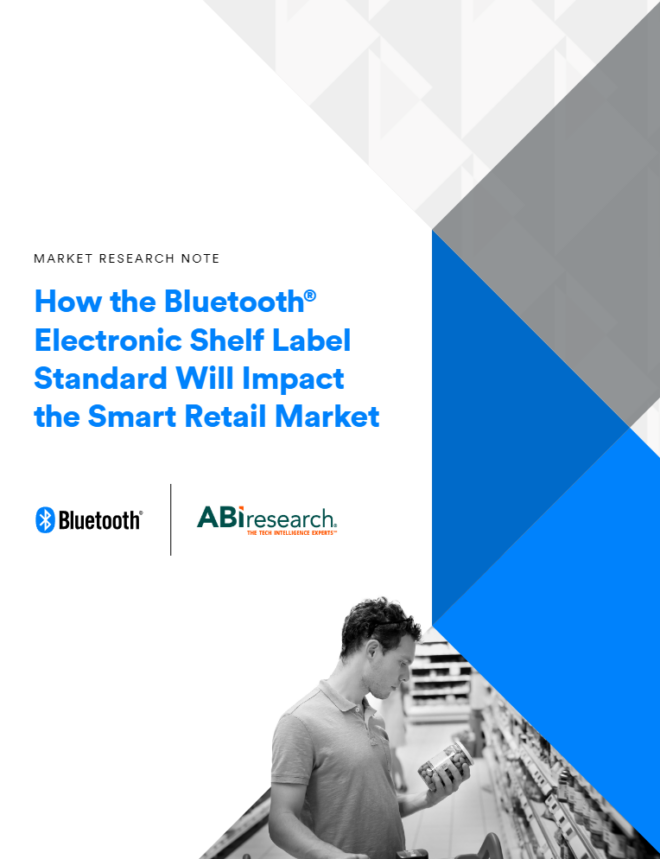From 5G-enabled smartphones and gaming devices to smart vehicles, smart industry, and smart cities, Qualcomm Technologies, Inc. connects products and technologies you interact with every day. Qualcomm Technologies’ innovations power the Edge, delivering significant value across multiple industries and to billions of people every day.
Art Miller, VP business development and global head of retail IoT at Qualcomm Technologies, Inc., recently had an opportunity to discuss Qualcomm Technologies’ involvement in developing a Bluetooth® standard for electronic shelf labels (ESL) and the effects this standard will have on the industry.
Q&A With Art Miller From Qualcomm Technologies, Inc.
What has been Qualcomm Technologies’ involvement in the Bluetooth® Electronic Shelf Label (ESL) Profile and Specification?
Qualcomm Technologies and SES-imagotag participated in the Bluetooth SIG working group to help establish the new standard with the end goal of creating a scalable, ultra-low power, security-rich, standard-based electronic shelf label (ESL) to enable retailers to improve operational efficiencies, empower employees, and enhance their customers’ experiences.
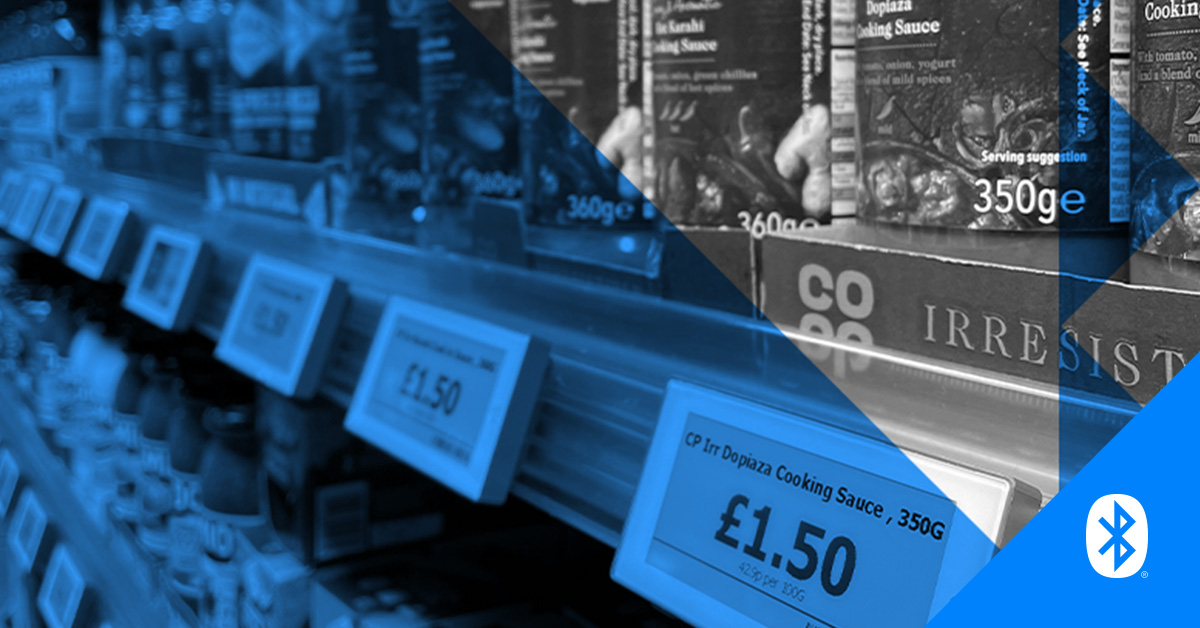
What is Qualcomm Technologies’ experience with electronic shelf labels?
Qualcomm Technologies powers ESLs and enables multi-function capabilities. We participated in the development of the Bluetooth® standard, both the new feature in the Bluetooth Core Specification (PAwR) and the profile. We collaborated with SES-Imagotag to create retail solutions that use and extend the standard. We helped define the system architecture and end-to-end security for standards-based ESLs, and Qualcomm Technologies developed a new chipset to enable Bluetooth ESLs.
To create a successful ESL for the retail market, an ESL should support ultra-low power, reliable communication, seconds-bound latency, end-to-end security (protocol-based and beyond), low cost, multiple vendor interoperability, scalability (able to handle 100K+ devices), and have the ability to transfer several kilobytes of data across a large number of devices.
What is the current state of ESLs, and why is it important to have a standard-based technology for ESLs?
ESLs have seen a steady uptake over the last decade and an even more aggressive adoption over the last few years. However, until now, ESL systems have relied on proprietary protocols for wireless communication, not only creating potential barriers to global adoption but also limiting retailers to create a single, smart retail ecosystem. Because of this, ESLs have yet to reach their full potential.
The introduction of a single, standards-based ESL solution is an important milestone for the industry because it provides retailers with a one-stop shop for their wireless communication needs from everywhere within the ecosystem. Whether it’s back-of-house, on the store floor, or checkout, there are numerous devices that need to communicate effectively with each other. The new Bluetooth® ESL standard should alleviate these problems and unlock new opportunities for retailers like never before.
What benefits do Bluetooth ESLs bring to retail and industrial markets, and what other market opportunities exist?
ESL opportunities certainly extend beyond retail. Industries such as manufacturing can benefit from dynamic parts management or workflow instruction. In office environments, ESL can provide a way to personalize shared space as hoteling or reserved space becomes more common. The applications and benefits of ESL are as varied as fixed signage or paper tags are today.
Bluetooth® technology allows retailers and other industries to benefit from a broad ecosystem of solutions providers instead of being dependent on proprietary implementations from a single OEM. Utilizing Bluetooth technology also helps to unify communication between multiple devices within a store or industrial setting.
FEATURED INNOVATION
Bluetooth Electronic Shelf Labels (ESL)
With the introduction of a wireless standard for the electronic shelf label (ESL) market, Bluetooth® technology is helping unlock the next chapter in in-store digital transformation to deliver better retail outcomes for both stores and shoppers.
How will Bluetooth ESLs improve operational efficiencies?
Updating traditional paper price tags is time consuming and sometimes burdensome. In some cases, store employees would need to print and re-tag store shelves several times a day. As omnichannel retail continues to grow, the frequency of pricing updates will continue to grow. In addition, as buying online, pickup at the store, and delivery demand increases, picking efficiency by store associates or third-party services will need to be more efficient. Bluetooth® ESLs can enable retailers to better manage and automate pricing, saving countless hours and employee resources as well as improving picking efficiency.
What is the range of Bluetooth communication for ESLs?
The range of a Bluetooth® signal can be quite impressive these days. In a typical deployment, the star topology defined between central (access point) to peripherals (ESL) can be within a radius of 10 to 15 meters. However, this all this depends on the amount of energy an ESL is willing to consume for transmitting its responses.
Can Bluetooth enabled ESLs be used in environments with high levels of interference, such as retail stores with a lot of electronic equipment?
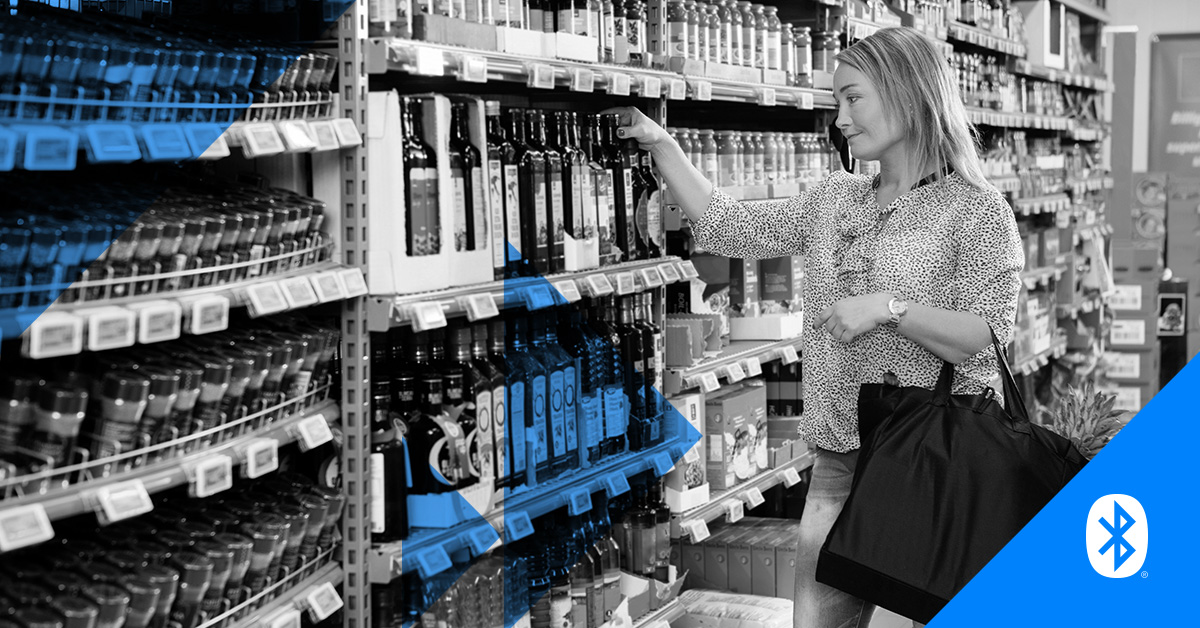
The standard approach taken by Bluetooth® Low Energy (LE) of frequency hopping has been demonstrated to be a suitable solution in most configurations. Unavoidably, there will always be a context where any RF systems will fail. Current deployments in large retail spaces have so far proven this assertion.
Fortunately, ESLs have limited exposure to these channels. As they only need to rely on them during the initial onboarding phases, ESLs will spend the vast majority of their lifecycle away from these and only use the whole set of available data channels. Furthermore, the ESL protocol has been designed to not create interferences that would increase as the number of deployed ESLs increase. Interferences between the access point (central) is limited to the probability of co-selection of the data channel – this will be naturally low on the basis of two key parameters, namely, random selection of the access address (a seed to the hopping frequency channel selection) and temporal diversity of the initiation of the periodic advertisement train per the access point.
What is the expected battery life of Bluetooth® enabled ESLs, and what is the cost of implementation as compared to other technologies?
A typical coin-cell battery will allow an ESL to stay in communication for many years, typically five to seven years. It is important to understand that the power cost is dominated, not by the protocol, but by all the adjacent functions associated with an ESL – mainly the refreshing of the display.
Unification of the ESL protocol as part of the Bluetooth® standard should bring economies of scale that will make Bluetooth technology more competitive than proprietary solutions. However, the actual cost of the ESL is primarily driven by many factors, such as display size, power requirements, access-point deployment, etc.
![]()
FEATURED REPORT
How the Bluetooth® Electronic Shelf Label Standard Will Impact the Smart Retail Market
ABI Research explores how the recent arrival of the new Bluetooth® Electronic Shelf Label (ESL) standard will help create an interoperable ESL ecosystem that can address many of the challenges being faced by retail and other environments.
5G対応スマートフォンやゲーム機から、スマートビークル、スマート産業、スマートシティに至るまで、クアルコム・テクノロジーズは人々が日常的に接する商品やサービスに組み込まれる技術を開発しています。そのイノベーションはエッジコンピューティングを推進し、さまざまな業界や何十億もの人々に日々大きな価値を届けています。
先日、クアルコム・テクノロジーズの事業開発バイスプレジデント兼リテール部門責任者であるアート・ミラー(Art Miller)氏に、電子棚札(ESL)のBluetooth®︎規格の開発における同社の関わりと、この規格が業界にもたらす影響についてお話を伺う機会がありました。
クアルコム・テクノロジーズのアート・ミラー氏とのQ&A
クアルコム・テクノロジーズがBluetooth®︎ ESLのプロファイルと仕様にどのように関わってきたか教えてください。
当社はSES-imagotag とともに、Bluetooth SIGのワーキンググループに参加し、新しい規格の策定に協力しました。この規格の最終目標は、 小売業者の業務効率化、従業員の裁量拡大、顧客体験の向上を可能にする、拡張性が高く超低消費電力で、セキュリティ機能豊富な標準規格ベースのESLを生み出すことに置かれました。
クアルコム・テクノロジーズはESLに関して、これまでどのような経験をお持ちでしょうか。

クアルコム・テクノロジーズはESLの実現を支え、より幅広い機能拡張を可能にしています。当社はBluetoothコア仕様の新機能(PAwR レスポンス付き定期アドバタイズ)とプロファイルの両方でBluetooth®︎規格の開発に参加しました。SES-imagotagと協力し、規格を使用、拡張する小売市場向けソリューションも開発しています。標準規格対応ESLのシステムアーキテクチャとエンドツーエンドのセキュリティの策定に協力し、Bluetooth ESLを実現するための新しいチップセットを当社で開発しました。
小売市場向けのESLとして成功するには、超低消費電力、信頼性の高い通信、秒単位の遅延、エンドツーエンドのセキュリティ(プロトコルベースおよびその他)を備えている必要があります。さらに、低コストで複数ベンダー間の相互運用性と高い拡張性(10万台以上のデバイスに対応)を持ち、大量のデバイスへの数キロバイトのデータ転送に対応できなければなりません。
ESLの現在の状況と、ESLに標準規格ベースの技術があることが重要である理由とは。
ESLは過去10年間に着実に普及し、ここ数年はさらに積極的な採用が進められています。ところがこれまで、ESLシステムでは各社独自の無線通信プロトコルが使用されていました。そのことは、世界的な普及への障害となり得るだけでなく、スマートリテールのエコシステムが小売業者ごとに独自に構築されるにとどまる原因ともなり、ESLのポテンシャルが最大限活用されるに至らない理由となっていました。
単一かつ標準規格ベースのESLソリューションの登場は、業界にとって重要な節目です。これによりエコシステム内のあらゆる場所から、小売業者のワイヤレス通信に関するすべてのニーズに対して、ワンストップで応じることが可能になります。バックヤード、売り場、店内レジなどには数多くの電子機器があり、効率的に相互に通信できる必要があります。新しいBluetooth®︎ ESL規格はこうした課題をより対処しやすくし、小売業者に対してかつてない新しい可能性を切り拓きます。
Bluetooth ESLは小売業や市場にどのようなメリットをもたらしますか。ほかにどのような市場で活用できる可能性があるでしょうか。
ESLには間違いなく、小売業の分野にとどまらない可能性があります。製造業などでも動的な部品管理や作業指示に活用できます。オフィス環境では、「ホテリング」、つまり座席やスペースの予約がより一般的になるにつれ、共有スペースをよりパーソナライズして提供する手段となり得ます。ESLの用途とメリットは、現在さまざまな用途で使用される看板や紙のタグと同様、多岐にわたります。
Bluetooth®︎技術は、小売業をはじめとするさまざまな業界に対して、数多くの企業によって幅広いソリューションが提供されるエコシステムの利用を可能にし、一つのメーカーが提供する独自の手段に頼らざるを得ない状況から脱するメリットをもたらします。またBluetooth技術を用いることによって、店舗や産業施設内での複数機器の間の通信手段の統一にも役立ちます。
Bluetooth ESLはどのように業務効率を向上させますか。
従来の紙製の値札の表示変更には時間がかかり、作業的にも大きな負担です。店舗従業員は、場合によっては1日数回にもわたり、商品棚の値札を印刷しては貼り直す作業を必要とします。オムニチャネル型の小売業が拡大するにつれ、価格を変える頻度も増えています。その上、オンライン購入、店舗受け取り、配送需要の拡大によって、店舗従業員や外部事業者によるピッキング作業の効率化も求められています。Bluetooth®︎ ESLによって、小売業者は価格表示の管理と自動化の効率向上を図ることができ、時間と労力を大幅に節約できます。また、ピッキング作業の効率向上も可能です。
Bluetooth ESLの通信範囲
最近のBluetooth®︎の通信範囲はかなり広くなっています。典型的な導入では、セントラル(アクセスポイント)と周辺機器(ESL)によって構成されるスター型トポロジーの半径は10メートルから15メートルまで可能です。ただし、すべてはESLが応答を返す際に消費できる電力量に依存します。
Bluetooth対応ESLは、電子機器の多い店舗など、干渉の多い環境でも使用できますか。

干渉対策としては、Bluetooth®︎ LEの標準的な対応方法である周波数ホッピングが、ほとんどの設置形態において適していることが分かっています。どのような無線周波数システムでも、機能できない環境が出てくることは避けられません。このことは、現在の大型店舗での導入で明らかに示されています。
幸いなことに、ESLが干渉の可能性のあるチャンネルにさらされるタイミングは限られています。それらを使用するのは導入時のみであり、ESLの稼動期間の大部分はこれらとは無関係のデータチャンネルだけを使用します。加えてESLプロトコルは、実装するESLの数の増加に伴って干渉が増えることのないよう設計されています。アクセスポイント(セントラル)間の干渉は、同じデータチャンネルを選んでしまった場合に限られます。この選択には2つの主な要素、すなわちアクセスアドレス(周波数ホッピングのチャンネル選択の初期値)と、アクセスポイントの定期アドバタイズメント開始の時間的多様性が関係するため、同じになる確率は自ずと低くなります。
Bluetooth®︎ ESLのバッテリー寿命はどの程度の予測でしょうか。他の技術に比べ、導入コストはどの程度となるでしょう。
ESLは一般的なコイン電池で数年にわたり、通常5年から7年ほど使用できます。理解しておくべき重要な点は、電力消費を左右するのはプロトコルではなく、ESLに関連したすべての機能、主にディスプレイ表示の更新だということです。
Bluetooth®︎規格の一環としてESLプロトコルが統一化され、スケールメリットが生まれることにより、Bluetooth技術は個別の独自ソリューションに比べ高い競争力を発揮するでしょう。ただしESLについて実際に発生するコストは、ディスプレイの大きさ、電力消費要件、アクセスポイントの展開といった数多くの要素によって決定付けられます。








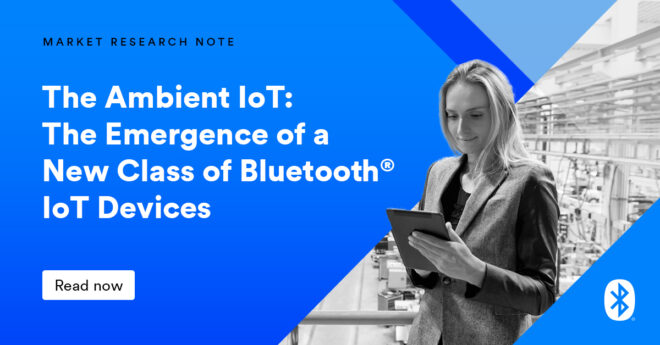
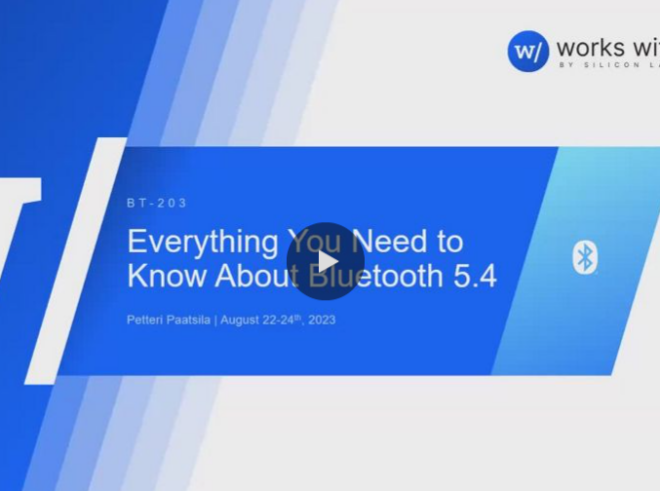
![hqdefault[1]](https://www.bluetooth.com/wp-content/uploads/2023/08/hqdefault1.jpg)
